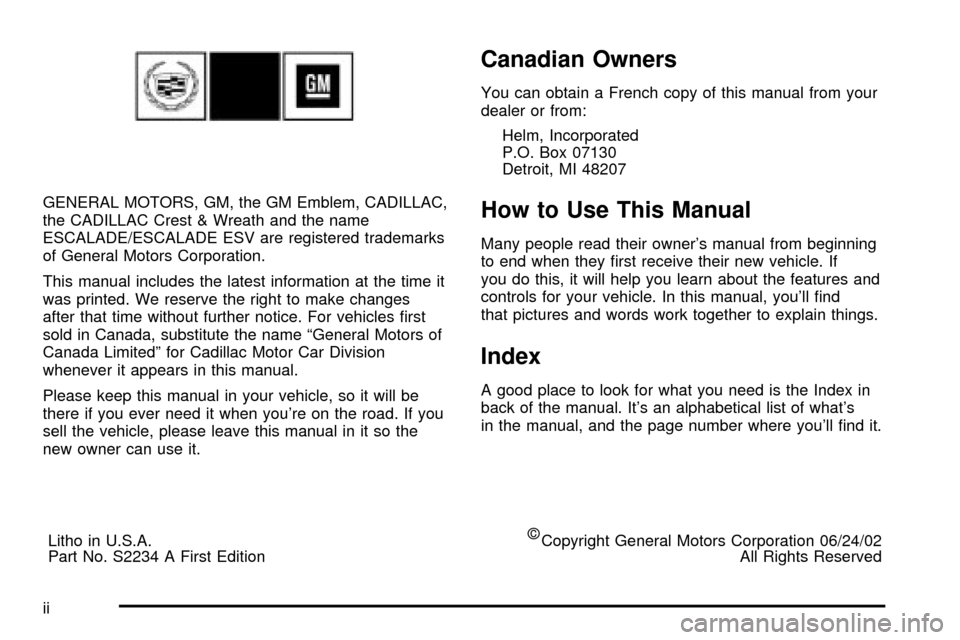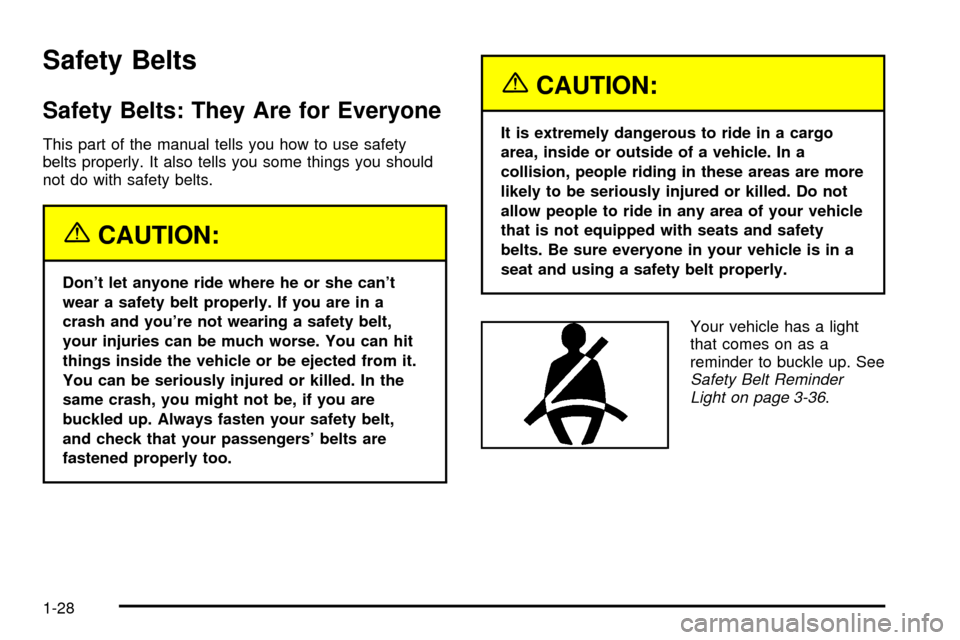Page 2 of 486

GENERAL MOTORS, GM, the GM Emblem, CADILLAC,
the CADILLAC Crest & Wreath and the name
ESCALADE/ESCALADE ESV are registered trademarks
of General Motors Corporation.
This manual includes the latest information at the time it
was printed. We reserve the right to make changes
after that time without further notice. For vehicles ®rst
sold in Canada, substitute the name ªGeneral Motors of
Canada Limitedº for Cadillac Motor Car Division
whenever it appears in this manual.
Please keep this manual in your vehicle, so it will be
there if you ever need it when you're on the road. If you
sell the vehicle, please leave this manual in it so the
new owner can use it.
Litho in U.S.A.
Part No. S2234 A First Edition
Copyright General Motors Corporation 06/24/02
All Rights Reserved
Canadian Owners
You can obtain a French copy of this manual from your
dealer or from:
Helm, Incorporated
P.O. Box 07130
Detroit, MI 48207
How to Use This Manual
Many people read their owner's manual from beginning
to end when they ®rst receive their new vehicle. If
you do this, it will help you learn about the features and
controls for your vehicle. In this manual, you'll ®nd
that pictures and words work together to explain things.
Index
A good place to look for what you need is the Index in
back of the manual. It's an alphabetical list of what's
in the manual, and the page number where you'll ®nd it.
ii
Page 9 of 486
Front Seats
Power Seats
Horizontal Control:You can adjust your vehicle's front
seats with the horizontal control located on the
outboard edge of each front seat.Raise or lower the front of the seat by raising or
lowering the forward edge of the control. Raise or lower
the rear of the seat by raising or lowering the rear
edge of the control.
Move the seat forward or rearward by moving the whole
control toward the front or toward the rear of the
vehicle.
Moving the whole control up or down raises or lowers
the entire seat cushion.
Vertical Control:You can use the vertical control to
adjust the angle of the seatback. Move the reclining
seatback forward or rearward by moving the top of the
control toward the front or toward the rear of the
vehicle.
For information on the reclining seatbacks, see
Reclining
Seatbacks on page 1-6.
Your vehicle may have a memory function which allows
seat settings to be saved and recalled. See
Memory
Seat on page 2-50for more information.
1-3
Page 10 of 486
Power Lumbar
You can increase or
decrease lumbar support
in an area of the lower
seatback.To increase support, press and hold the front of the
control. To decrease support, press and hold the rear of
the control. Let go of the control when the lower
seatback reaches the desired level of support.
You can also reshape the side wing area of the lower
seatback for more lateral support.
To increase support, press and hold the top of the
control. To decrease support, press and hold the bottom
of the control. Let go of the control when the lower
seatback reaches the desired level of support.
Your vehicle may have a memory function which allows
seat settings to be saved and recalled. See
Memory
Seat on page 2-50for more information.
1-4
Page 11 of 486

Heated Seats
The buttons used to
control this feature are
located on the front doors.
The engine must be
running for the heated seat
feature to work.To heat the entire seat, press the horizontal button with
the heated seat symbol. Press the button to cycle
through the temperature settings of high, medium and
low and to turn the heated seat off. Indicator lights
will glow to designate the level of heat selected, three
for high, two for medium, and one for low.
The low setting warms the seatback and cushion until
the seat temperature is near body temperature. The
medium and high settings heat the seatback and seat
cushion to a slightly higher temperature. You will be able
to feel heat in about two minutes.
To heat only the seatback, press the vertical button with
the heated seatback symbol. An indicator light on the
seatback button will glow to designate that only the
seatback is being heated. Additional presses of
the seatback button will cycle through the heat levels for
the seatback only. Press the horizontal button again
to heat the whole seat.
The heated front seats will shut off automatically when
the ignition is turned off.
Your vehicle also has heated rear seats. See
Heated
Seats on page 1-10.
1-5
Page 12 of 486
Reclining Seatbacks
Your vehicle's front seatbacks have a recline feature
which is described earlier. SeePower Seats on
page 1-3.
But don't have a seatback reclined if your vehicle is
moving.
{CAUTION:
Sitting in a reclined position when your vehicle
is in motion can be dangerous. Even if you
buckle up, your safety belts can't do their job
when you're reclined like this.
The shoulder belt can't do its job. In a crash,
you could go into it, receiving neck or other
injuries.
The lap belt can't do its job either. In a crash
the belt could go up over your abdomen. The
belt forces would be there, not at your pelvic
bones. This could cause serious internal
injuries.
For proper protection when the vehicle is in
motion, have the seatback upright. Then sit
well back in the seat and wear your safety belt
properly.
1-6
Page 14 of 486
Rear Seats
Rear Seat Operation
Entering or Exiting the Third Row
Seats
Escalade:To enter or exit the third row seat you must
fold the second row seat down following the instructions
later in this section. See ªFolding the Seatbackº
under
60/40 Split Bench Seat on page 1-10.If you are exiting the third row seat with no assistance
do the following:
1. Reach over the second
row seat and pull up on
the strap loop. Then
pull the seat cushion up
and push it forward.
2. Next, push the seatback forward until it is ¯at with
the ¯oor.
Be sure to return the seat to the passenger position
when ®nished. Pull forward and push rearward on the
seat to make sure it is locked in place.
Escalade ESV:The passenger's side of the second
row 60/40 or rear bucket seat has an easy entry/exit
feature. This makes it easy to get in and out of the third
row seat.
1-8
Page 34 of 486

Safety Belts
Safety Belts: They Are for Everyone
This part of the manual tells you how to use safety
belts properly. It also tells you some things you should
not do with safety belts.
{CAUTION:
Don't let anyone ride where he or she can't
wear a safety belt properly. If you are in a
crash and you're not wearing a safety belt,
your injuries can be much worse. You can hit
things inside the vehicle or be ejected from it.
You can be seriously injured or killed. In the
same crash, you might not be, if you are
buckled up. Always fasten your safety belt,
and check that your passengers' belts are
fastened properly too.
{CAUTION:
It is extremely dangerous to ride in a cargo
area, inside or outside of a vehicle. In a
collision, people riding in these areas are more
likely to be seriously injured or killed. Do not
allow people to ride in any area of your vehicle
that is not equipped with seats and safety
belts. Be sure everyone in your vehicle is in a
seat and using a safety belt properly.
Your vehicle has a light
that comes on as a
reminder to buckle up. See
Safety Belt Reminder
Light on page 3-36.
1-28
Page 39 of 486

Q:If I'm a good driver, and I never drive far from
home, why should I wear safety belts?
A:You may be an excellent driver, but if you're in an
accident ± even one that isn't your fault ± you and
your passengers can be hurt. Being a good
driver doesn't protect you from things beyond your
control, such as bad drivers.
Most accidents occur within 25 miles (40 km) of
home. And the greatest number of serious injuries
and deaths occur at speeds of less than
40 mph (65 km/h).
Safety belts are for everyone.
How to Wear Safety Belts Properly
This part is only for people of adult size.
Be aware that there are special things to know about
safety belts and children. And there are different
rules for smaller children and babies. If a child will be
riding in your vehicle, see
Older Children on page 1-51orInfants and Young Children on page 1-53. Follow
those rules for everyone's protection.
First, you'll want to know which restraint systems your
vehicle has.
We'll start with the driver position.
1-33